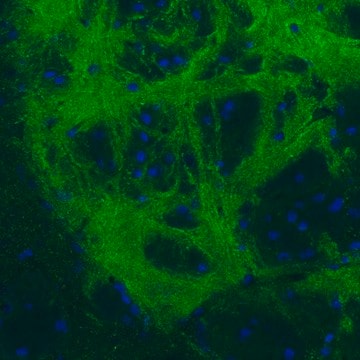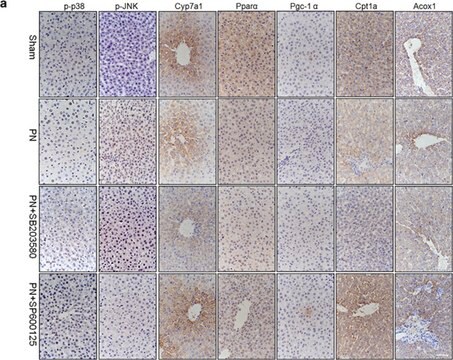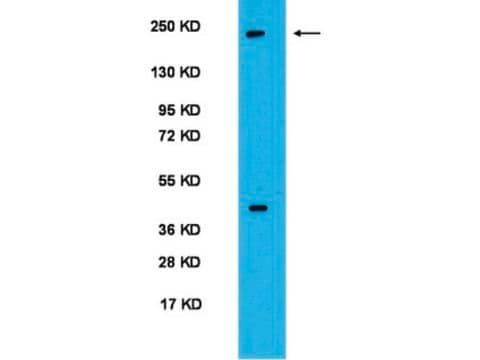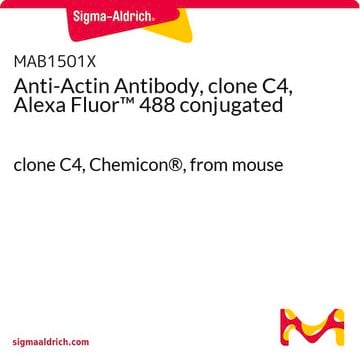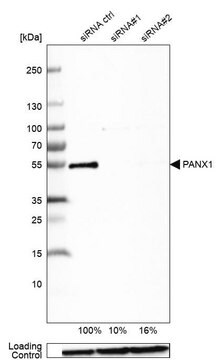推荐产品
生物源
rabbit
品質等級
抗體表格
purified antibody
抗體產品種類
primary antibodies
無性繁殖
SC50-3, monoclonal
物種活性
human, E. coli
物種活性(以同源性預測)
all
技術
dot blot: suitable
western blot: suitable
同型
IgG
運輸包裝
wet ice
目標翻譯後修改
phosphorylation (N1-pHis)
一般說明
Phosphorylation plays an important role in regulating protein activities and various cellular signaling events in cells. Limited by the tools available for phosphohistidine (pHis) detection, the majority of studies focus on serine, threonine, and tyrosine phosphorylations. Histidine phosphorylation can occur at either N1 (1-pHis) or N3 (3-pHis) of the imidazole ring. The development of peptides containing stable phosphoryltriazolylalanine analogues of 1-pHis and 3-pHis (1-pTza and 3-pTza) allows the generation of antibodies for studying both histidine N1 and N3 phosphorylations in signaling events. There is growing evidence implicating His kinases in cancer and tumor metastasis and the first metastasis suppressor gene identified is one of the two known mammalian His kinases, Nm23-H1 (also known as NME1, nucleoside diphosphate kinase, or NDPK-A). Nm23-H1/NME1 and the closely related Nm23-H2 (NME2/NDPK-B) catalyze the transfer of phosphate from ATP onto Nucleoside-diphosphates (NDPs) through a 1-pHis enzyme intermediate. Nm23-H1/-H2 also possess His kinase activity, transferring the phosphate from the active site pHis onto a His in a target protein. Metabolic enzymes such as phosphoglycerate mutase (PGAM), succinyl CoA synthase (SCS), and ATP citrate lyase (ACL) also use pHis as an enzyme intermediate. Unlike NME1/2, PGAM uses 3-pHis as an enzyme intermediate. In addition to eukaryotes, histidine phosphorylation is well documented in bacterial “two-component” signaling pathways involved in chemotaxis, although the phosphate is transferred from the pHis formed in the receptor/sensor protein to Asp residues of an acceptor response regulator protein, and the receptor/sensor protein essentially functions as an aspartate kinase.
特異性
Selectively detects proteins with histidine(s) phosphorylated at N1 of the imidazole ring (1-pHis), but not 3-pHis.
Target modification is not species specific.
免疫原
Epitope: N1-phosphohistidine (1-pHis)
KLH-conjugated library of random peptides containing non-hydrolyzable phosphohistidine analogue 1-pTza.
應用
Anti-N1-Phosphohistidine (1-pHis) antibody, clone SC50-3 is an isomer-specific monoclonal Ab to specifically detect histidine phosphorylated at position N1. This purified mAb is backed by published data demonstrating performance in Western blotting and dot blot applications.
Dot Blot Analysis: A representative lot detected peptides containing 1-pTza, but not 3-pTza phosphohistidine analogue. Clone SC50-3 displayed no immunoreactivity toward peptides containing only phosphorylated tyrosine or non-phosphorylated histidine (Fuhs, S.R., et al. (2015). Cell. 162(1):198-210).
Western Blotting Analysis: Clone SC50-3 hybridoma culture supernatant was employed for Western blotting analysis of heat-sensitive histidine N1-phosphorylation (1-pHis) of exogenously expressed NM23-H1/NME1 fusion proteins in lysates from transformed E. coli and HEK293 transfectants (Fuhs, S.R., et al. (2015). Cell. 162(1):198-210).
Note: DO NOT HEAT SAMPLES prior to phosphohistidine detection. Histidine phosphorylation is heat and acid labile. To generate negative control for specificity test, an aliquot of sample can be heated at 95ºC for 10-15 minutes to reverse histidine phosphorylation. Alternatively, an aliquot of sample can be incubated under acidified pH at 37ºC for 15 minutes to reduce histidine phosphorylation. Acidify each 100 µL sample with 25 µL of 1 M HCl before the incubation, then neutralize with 25 µL of 1 M NaOH prior to phosphohistidine detection.
Western Blotting Analysis: Clone SC50-3 hybridoma culture supernatant was employed for Western blotting analysis of heat-sensitive histidine N1-phosphorylation (1-pHis) of exogenously expressed NM23-H1/NME1 fusion proteins in lysates from transformed E. coli and HEK293 transfectants (Fuhs, S.R., et al. (2015). Cell. 162(1):198-210).
Note: DO NOT HEAT SAMPLES prior to phosphohistidine detection. Histidine phosphorylation is heat and acid labile. To generate negative control for specificity test, an aliquot of sample can be heated at 95ºC for 10-15 minutes to reverse histidine phosphorylation. Alternatively, an aliquot of sample can be incubated under acidified pH at 37ºC for 15 minutes to reduce histidine phosphorylation. Acidify each 100 µL sample with 25 µL of 1 M HCl before the incubation, then neutralize with 25 µL of 1 M NaOH prior to phosphohistidine detection.
品質
Evaluated by Western Blotting of NME1 autophosphorylation reaction.
Western Blotting Analysis: 0.24 µg/mL of this antibody detected recombinant human NME1 (NM23-H1) with N1-phosphohistidine (1-pHis) in a 5 µg aliquot of autophosphorylation reaction.
Western Blotting Analysis: 0.24 µg/mL of this antibody detected recombinant human NME1 (NM23-H1) with N1-phosphohistidine (1-pHis) in a 5 µg aliquot of autophosphorylation reaction.
標靶描述
Variable depending on the histidine-phosphorylated proteins.
外觀
Format: Purified
其他說明
Concentration: Please refer to lot specific datasheet.
Not finding the right product?
Try our 产品选型工具.
儲存類別代碼
12 - Non Combustible Liquids
水污染物質分類(WGK)
WGK 1
閃點(°F)
Not applicable
閃點(°C)
Not applicable
Joo Ae Kang et al.
Journal of microbiology and biotechnology, 30(2), 306-312 (2019-11-23)
Despite the importance of brown adipocytes as a therapeutic target for the prevention and treatment of obesity, the molecular mechanism underlying brown adipocyte differentiation is not fully understood. In particular, the role of post-translational modifications in brown adipocyte differentiation has
Rajasree Kalagiri et al.
Methods in molecular biology (Clifton, N.J.), 2077, 181-191 (2019-11-11)
Immunoblotting is a ubiquitous immunological technique that aids in detecting and quantifying proteins (including those of lower abundance) and their posttranslational modifications such as phosphorylation, acetylation, ubiquitylation, and sumoylation. The technique involves electrophoretically separating proteins on an SDS-PAGE gel, transferring
Ina Felix et al.
International journal of molecular sciences, 21(9) (2020-05-10)
Some highly metastatic types of breast cancer show decreased intracellular levels of the tumor suppressor protein NME1, also known as nm23-H1 or nucleoside diphosphate kinase A (NDPK-A), which decreases cancer cell motility and metastasis. Since its activity is directly correlated
Chih-Wei Chen et al.
Proceedings of the National Academy of Sciences of the United States of America, 116(2), 566-574 (2018-12-28)
We report a patient who presented with congenital hypotonia, hypoventilation, and cerebellar histopathological alterations. Exome analysis revealed a homozygous mutation in the initiation codon of the NME3 gene, which encodes an NDP kinase. The initiation-codon mutation leads to deficiency in
Junyao Yang et al.
Stem cells (Dayton, Ohio), 38(4), 556-573 (2019-11-14)
Histone deacetylase 7 (HDAC7) plays a pivotal role in the maintenance of the endothelium integrity. In this study, we demonstrated that the intron-containing Hdac7 mRNA existed in the cytosol and that ribosomes bound to a short open reading frame (sORF)
我们的科学家团队拥有各种研究领域经验,包括生命科学、材料科学、化学合成、色谱、分析及许多其他领域.
联系技术服务部门

